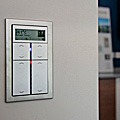
Not only can residential technology can improve the lives of elderly and disabled people, it also has the potential to reduce the burden on the medical and caring professions by enabling more of these people to remain in their homes. However, joined-up action is required if this potential is to be fulfilled. Phyllis Oberman reports from a recent conference.
Smart home technology will be a major contributor in ensuring that the vastly increasing numbers of older people in Britain can remain in their own homes with a good quality of life. In the next 10 years more than one-fifth the UK population will be over the age of 65 – increasing to 12.7 million. Numbers of those over 85 will increase to 1.9 million (according to the Government Actuary Department).
This phenomenon was the key theme throughout a seminar in London on 15 June organised by PhoneAbility, the charity whose objective is making information and communications technology (ICT) accessible to older and disabled people. More than 110 delegates attended the seminar at the Department for Business, Innovation & Skills (BIS) in Westminster, including architects, academics, representatives of age and disabled organisations, local authorities, researchers and charities.
Peter Bonfield, head of BRE (Building Research Establishment) stressed that the rapid ageing of the UK’s population means that hospitals, care homes, and other outside services will not be able to cope and that the system has to be re-balanced to provide care in the home helping to prevent illness and accidents. These enormous demographic changes are forcing the need to address this issue. The BRE is proactively working with Government, the EU and internationally to show how smart home technology can be integrated into everyday life. Examples of assistive living are on show at BRE’s Innovation Park at Watford, Hertfordshire. (Pictured is a programmable KNX control in the Osborne house on the Innovation Park.) BRE offers tours and technology training.
Martyn Gilbert from UK3.0 quoted Dr. John Gill, director of PhoneAbility, who said, “What’s good design for older and disabled people is good design for us all.” He said that UK3.0 is proposing a nationwide infrastructure to implement the strategy that will provide care in the home to facilitate independence. Retrofitting smart living technology is crucially important. People take for granted the technology provided in today’s cars, and this integrated facility must be applied in the home. “You don’t know it is there,” he added. All the technology that is needed is here today and it is mostly mature and trouble-free. Help for older and disabled needs to be not just smart but also reliable, private and secure. “Moving information rather than moving people and things saves money and energy. There needs to be active collaboration between the public and the private sector to ensure that basic ICT features become the norm.”
Many speakers pointed out that the present and future economic constraints will mean that the nation will not be able to afford to fund the cost of care in hospitals or care homes for the hugely increased numbers of older people. Nor should it be necessary if smart home technology is brought into play.
The associate director of strategic research at BRE, Peter Ball, highlighted the cost savings that could be achieved by getting smart technology into the mainstream. “It’s all about quality of life,” he said. “I am not convinced that our future requirements will need specialist technologies.” He invited delegates to visit BRE where demonstration houses showed the diverse ways that smart technology can aid health and well-being, entertainment, access control, security, accessibility and quality of life. “It has to be mainstream to make it affordable”.
Some other recent developments in this area include:
• The Technology Strategy Board (www.innovateuk.org) has announced £10 million to be invested in developing innovative technology and services for independent living.
• A report has just been published, commissioned by Ofcom, investigating how assisted living technologies might help older and disabled people live longer and richer lives at home over the next 20 years. A summary of the report can be obtained from Plum Consulting – [email protected]
• The British Standards Institute defines inclusive design as “the design of mainstream products and services that are accessible to, and usable by, as many people as reasonably possible without the need for special adaptation or specialised design”.
• CARDIAC – an organisation advancing research and development in the area of accessible and assistive technology – is carrying out a three-year research project to advise the EU where to devote funding over the next 10 years.
Picture: Peter White, courtesy of BRE
Phyllis Oberman can be contacted at [email protected]
www.bre.co.uk
www.cardiac-eu.org
www.innovateuk.org
www.phoneability.org.uk
www.uk3point0.com







